商品详情
返回产品目录商品包装及说明书因厂家更换频繁,如有不符以实物为主
他拉唑帕利胶囊
国际零售参考价:¥**/瓶
产品参数 中文说明 外文说明关联产品 本品资讯
-
- 通用名称
- 他拉唑帕利胶囊
- 商品名
- Talzenna
- 其它名称
- 特索力、他拉唑帕尼、他唑帕利、他唑帕尼、他唑巴利布、他唑来膦、Talazoparib
- 英文名称
- talazoparib capsules
- 包装规格
- 1mg×30粒
- 产地及厂家
- 辉瑞(Pfizer)土耳其
- 适应症范围
- 乳腺癌
- 其它说明
- 可以预订
- 靶点
- PARP
-
温馨提醒:本说明书仅供参考,最新的说明书详见药品附带的说明书。
完整的处方信息
1适应症和用途
TALZENNA用于治疗患有有害或疑似有害种系的乳腺癌易感基因(BRCA)突变(gBRCAm)人表皮生长因子受体2(HER2)阴性的局部晚期或转移性乳腺癌的成年患者。根据FDA批准的TALZENNA 伴随诊断选择患者进行治疗[请参阅剂量和给药方法(2.1) ]。
2用法用量
2.1患者选择
根据种系BRCA突变的存在,选择使用TALZENNA治疗晚期乳腺癌的患者[请参阅适应症和用法(1),临床研究(14) ]。可通过http://www.fda.gov/companiondiagnostics获得FDA批准的检测BRCA突变的测试信息。
2.2推荐剂量
推荐的TALZENNA剂量为1毫克,每天口服一次,有或没有食物。
0.25 mg胶囊可用于降低剂量。
应该对患者进行治疗,直到疾病进展或出现不可接受的毒性。
硬胶囊应完全吞下,不得打开或溶解。如果患者呕吐或未服药,则不应再服药。下一次处方剂量应在通常时间服用。
2.3不良反应的剂量修改
要处理不良反应,请根据严重程度和临床表现考虑中断治疗,减少或不减少剂量。表1和表2列出了建议的剂量减少量。如果需要减少剂量三次以上,应停止使用TALZENNA的治疗。
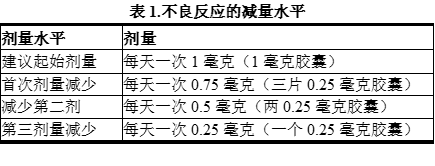
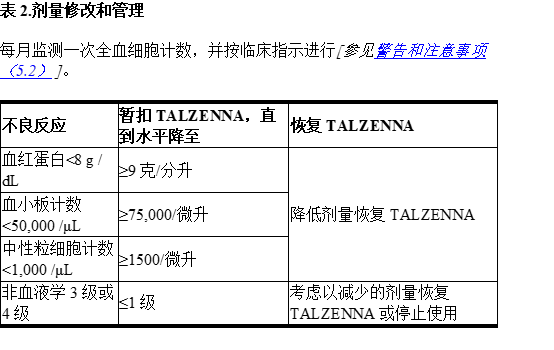
2.4肾功能不全患者的剂量调整
对于中度肾功能不全(CLcr 30 – 59 mL / min)的患者,TALZENNA的推荐剂量为每天 0.75 mg [请参见在特定人群中使用(8.6),临床药理学(12.3) ]。
2.5与P-糖蛋白(P-gp)抑制剂一起使用的剂量修饰
与某些P-gp抑制剂并用时,应将TALZENNA剂量降低至每天一次0.75 mg。有关相互作用的P-gp抑制剂的更多信息,请参见药物相互作用(7.1)和临床药理学(12.3)。
当停用P-gp抑制剂时,将TALZENNA剂量(在P-gp抑制剂的3–5半衰期之后)增加到开始使用P-gp抑制剂之前的剂量[请参阅药物相互作用(7.1),临床药理学(12.3) ]。
3剂型和强度
胶囊:
- 0.25毫克胶囊,带有象牙色的盖子(黑色印有“辉瑞”)和白色机身(黑色印有“ TLZ 0.25”)
- 1毫克胶囊,带有浅红色的帽子(黑色印有“辉瑞”)和白色身体(黑色印有“ TLZ 1”)
4禁忌症
没有。
5警告和注意事项
5.1骨髓增生异常综合症/急性髓性白血病
据报道,接受TALZENNA治疗的患者患有骨髓增生异常综合症/急性髓性白血病(MDS / AML)。总体而言,在临床研究中,已有 584名(0.3%)接受TALZENNA治疗的实体瘤患者中有2名报告MDS / AML 。在发展MDS / AML之前,这两名患者的TALZENNA治疗持续时间分别为4个月和24个月。两名患者均已接受过铂类药物和/或其他DNA破坏性药物(包括放疗)的化学疗法。
在患者从先前的化学疗法引起的血液学毒性中完全康复之前,请勿开始使用TALZENNA。在基线时及其后每月监测全血细胞减少症的计数。对于长期的血液学毒性,应中断TALZENNA并每周监测血球计数直至恢复。如果4周后血脂水平仍未恢复,请将该患者转介至血液科医生进行进一步检查,包括进行骨髓分析和血液样本进行细胞遗传学检查。如果确认了MDS / AML,请终止TALZENNA。
5.2骨髓抑制
据报道,用TALZENNA 治疗的患者出现由贫血,白细胞减少/中性粒细胞减少和/或血小板减少组成的骨髓抑制[见不良反应(6) ]。据报道,接受TALZENNA治疗的患者中,≥3级贫血,中性粒细胞减少和血小板减少症发生率分别为39%,21%和15%。0.7%,0.3%和0.3%的患者分别因贫血,中性粒细胞减少和血小板减少而中断治疗。
在基线时及其后每月监测全血细胞计数,以减少血细胞减少。在患者从先前治疗引起的血液学毒性中完全康复之前,请勿开始使用TALZENNA。如果发生这种情况,建议调整剂量(减少剂量或不减少剂量的剂量中断)[请参阅剂量调整(2.3) ]。
5.3胚胎-胎儿毒性
根据其作用机理和从动物数据中得出的发现,TALZENNA对孕妇给药可引起胎儿伤害。在一项动物生殖研究中,在器官发生期间给怀孕的大鼠服用他拉莫帕尼会导致胎儿畸形和骨骼结构变异,以及暴露时胚胎-胎儿死亡的浓度是接受浓度-时间曲线(AUC)的患者的0.24倍建议的人剂量为每天1 mg。告知孕妇和具有生殖潜力的女性对胎儿的潜在危险。建议有生育潜力的女性在治疗期间以及末次服用TALZENNA 后至少7个月内使用有效的避孕药[请参阅“ 在特定人群中使用(8.1,8.3),临床药理学(12.1) ]。
根据遗传毒性和动物繁殖研究的结果,建议具有生殖潜能的女性伴侣或怀孕的男性患者在治疗期间以及末次服用TALZENNA 后至少4个月内使用有效避孕措施(请参阅“ 在特定人群中使用(8.1,8.3),非临床毒理学(13.1) ]。
6不良反应
标签上其他地方描述了以下临床上显着的不良反应:
- 骨髓增生异常综合症/急性髓性白血病[请参阅警告和注意事项(5.1) ]
- 骨髓抑制[请参阅警告和注意事项(5.2) ]
6.1临床试验经验
由于临床试验是在广泛不同的条件下进行的,因此无法将在某种药物的临床试验中观察到的不良反应率直接与另一种药物的临床试验中观察到的不良反应率进行比较,并且可能无法反映实际中观察到的不良反应率。
治疗gBRCAm HER2阴性的局部晚期或转移性乳腺癌
恩布拉卡
在HER2阴性的局部晚期或转移性乳腺癌的gBRCAm患者中评估了TALZENNA作为单一疗法的安全性,这些患者先前接受了不超过3线的化疗来治疗局部晚期/转移性疾病。EMBRACA是一项随机,开放标签,多中心研究,其中412名患者接受了医疗保健提供者选择的TALZENNA 1 mg每天一次(n = 286)或化疗药物(卡培他滨,依立布林,吉西他滨或长春瑞滨)的接受(n = 126),直到疾病进展或出现不可接受的毒性。接受TALZENNA治疗的患者的研究治疗中位时间为6.1个月接受化疗的患者为3.9个月。65%的接受TALZENNA的患者和50%的接受化疗的患者因任何级别的不良反应而导致给药中断;53%的TALZENNA患者和40%的化疗患者因任何原因导致剂量减少。5%的TALZENNA患者和6%的化疗患者因不良反应而永久停药。
表3和表4分别总结了在EMBRACA研究中接受TALZENNA或化学疗法治疗的患者中最常见的不良反应和实验室异常。
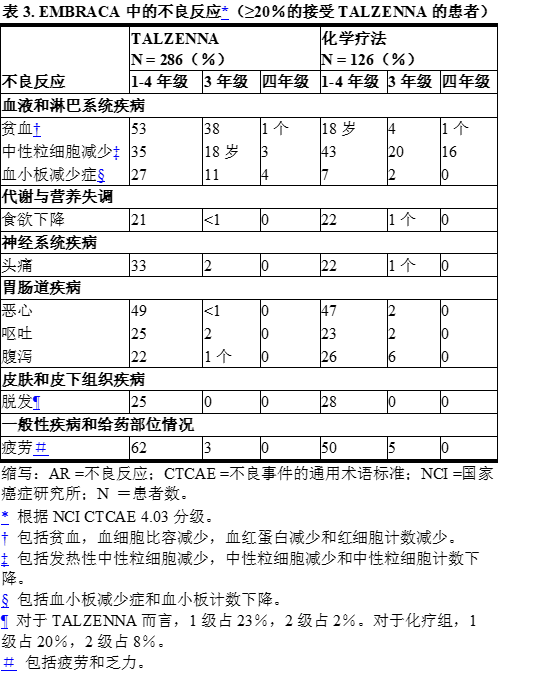
在286名接受TALZENNA的患者中,有20%以下发生了以下不良反应,因此未包括在表3中:腹痛(19%),头晕(17%),白细胞减少症(17%),消化不良(10%) ),消化不良(10%),口腔炎(8%)和淋巴细胞减少症(7%)。
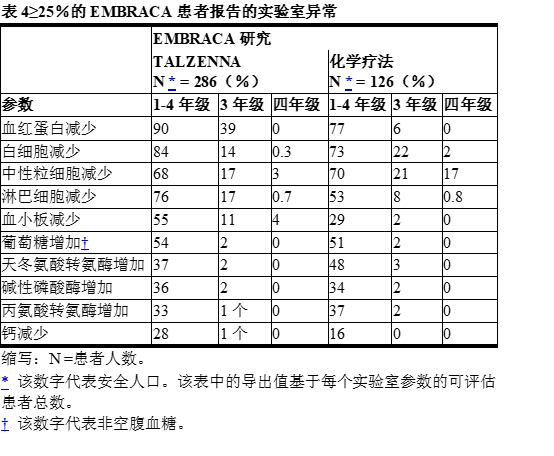
7药物相互作用
7.1其他药物对TALZENNA的作用
P-gp抑制剂的作用
与P-gp抑制剂共同给药可能会增加他拉唑帕尼的暴露。
在患有晚期实体瘤的患者中,P-gp抑制剂(伊曲康唑)的共同给药可使他拉唑帕尼的血浆暴露增加56%。在临床研究中,与P-gp抑制剂(包括胺碘酮,卡维地洛,克拉霉素,伊曲康唑和维拉帕米)共同给药可导致他唑帕尼的暴露量增加约45%,并且降低TALZENNA的剂量。如果不能避免将TALZENNA与这些P-gp抑制剂并用,请减少TALZENNA的剂量[见剂量和用法(2.5) ]。停用P-gp抑制剂后,增加TALZENNA剂量(在抑制剂的半衰期3–5之后)等于开始使用P-gp抑制剂之前的剂量[请参阅剂量和给药方法(2.5),临床药理学(12.3) ]。
当将TALZENNA与以上未列出的P-gp抑制剂并用时,监测患者潜在的不良反应增加[请参阅剂量和用法(2.5),临床药理学(12.3) ]。
BCRP抑制剂的作用
与BCRP抑制剂并用可能会增加他拉帕尼的暴露。如果无法避免共同给药,则在共同给药时监测患者潜在的不良反应增加[见临床药理学(12.3) ]。
8在特定人群中的使用
8.1怀孕
风险摘要
根据动物研究的结果及其作用机理[参见临床药理学(12.1) ],将TALZENNA给予孕妇会引起胚胎-胎儿的伤害。目前尚无有关孕妇中使用TALZENNA的数据以告知与药物相关的风险。在一项动物生殖研究中,在器官发生期间给怀孕的大鼠服用他唑帕尼会导致胎儿畸形和骨骼结构变化以及母体暴露时胚胎胎儿死亡,这是接受每日建议剂量1 mg的患者的AUC的0.24倍(见数据)。告知孕妇和具有生殖潜力的女性对胎儿的潜在危险。
对于所指示的人群,主要出生缺陷和流产的背景风险尚不清楚。在美国一般人群中,临床公认的怀孕中主要先天缺陷和流产的估计背景风险分别为2%至4%和15%至20%。
数据
动物资料
在一项胚胎-胎儿发育毒性研究中,怀孕的大鼠在器官发生期间接受了0.015、0.05和0.15 mg / kg /天的口服他拉帕尼的口服剂量。塔拉唑帕尼以≥0.015mg / kg /天的剂量(约建议剂量患者AUC的0.24倍)引起胚胎-胎儿死亡。每天0.015 mg / kg的剂量会导致胎儿体重下降,胎儿畸形(凹陷的眼球,小眼,胸骨裂和融合的颈椎弓形)发生率增加,并且结构变化(包括胸骨变形或不完全骨化)头骨,肋骨和椎骨。
8.2哺乳
风险摘要
没有关于人乳中他拉帕尼的存在,该药物对产奶量的影响或该药物对母乳喂养的孩子的影响的数据。由于使用他唑帕尼的母乳喂养的孩子可能会产生严重的不良反应,因此建议哺乳期妇女在使用TALZENNA治疗期间以及最终剂量后至少1个月内不要母乳喂养。
8.3生殖潜力的男性和女性
验孕
建议在开始使用TALZENNA治疗之前对有生殖能力的女性进行妊娠试验。
避孕
女性
当将TALZENNA用于孕妇时,可能会造成胎儿伤害[请参阅“ 在特定人群中使用(8.1)” ]。建议有生殖潜力的女性在治疗期间和最后一次TALZENNA给药后至少7个月内使用有效避孕。
雄性
根据遗传毒性和动物繁殖研究,建议具有生殖潜能的女性伴侣和怀孕伴侣的男性患者在使用TALZENNA治疗期间以及最后一次给药后至少4个月内使用有效的避孕药[请参见“ 在特殊人群中使用(8.1),非临床毒理学” (13.1) ]。
不孕症
雄性
根据动物研究,TALZENNA可能会损害具有生殖潜力的男性的生育能力[请参见非临床毒理学(13.1) ]。
8.4小儿使用
TALZENNA的安全性和有效性尚未在儿科患者中确立。
8.5老年人使用
在TALZENNA纳入的 494例实体瘤患者的临床试验中,他们每天接受TALZENNA 1 mg单药治疗,其中85岁(17%)≥65岁,其中19岁(4%)≥75岁。有5名≥85岁的患者。在这些患者和年轻患者之间,未观察到TALZENNA的安全性或有效性的总体差异,但不能排除某些老年患者的敏感性更高。
8.6肾功能不全
降低中度肾功能不全患者(CLcr 30 – 59 mL / min)的推荐剂量TALZENNA [参见剂量和用法(2.4),临床药理学(12.3) ]。轻度肾功能不全(CLcr 60 – 89 mL / min)的患者无需调整剂量。TALZENNA尚未在患有严重肾损伤(CLCR <30 mL /分钟)或需要血液透析患者进行了研究[见临床药理学(12.3) ]。
8.7肝功能不全
对于中度肝功能不全(总胆红素> 1.5至3.0×正常[ULN]上限和任何天冬氨酸转氨酶[AST]的上限)或严重肝功能不全(总胆红素> 3.0×ULN和任何AST)的患者,尚未进行TALZENNA的研究。轻度肝功能不全(总胆红素≤1×ULN和AST> ULN,或总胆红素> 1.0至1.5×ULN和任何AST)的患者无需调整剂量[见临床药理学(12.3) ]。
10过量
如果过量服用TALZENNA,则没有具体的治疗方法,并且尚未建立过量症状。如果发生过量,请停止使用TALZENNA的治疗,考虑进行胃净化,采取一般的支持措施并对症治疗。
11说明
Talazoparib是哺乳动物多腺苷5'-二磷酸核糖聚合酶(PARP)酶的抑制剂。他唑帕尼甲苯磺酸盐的化学名称为(8 S,9 R)-5-氟-8-(4-氟苯基)-9-(1-甲基-1 H -1,2,4-三唑-5-基)- 2,7,8,9-四氢-3 H-吡啶[4,3,2- de ]酞嗪-3-一4-甲基苯磺酸盐(1:1)。他唑帕尼甲苯磺酸盐的化学式为C 26 H 22 F 2 N 6 O 4 S,相对分子质量为552.56道尔顿。他唑帕尼甲苯磺酸盐的化学结构如下所示:
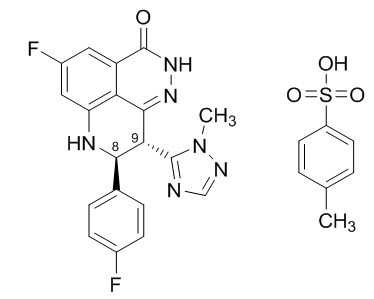
他拉帕尼甲苯磺酸盐为白色至黄色固体。口服的TALZENNA胶囊为0.25 mg硬质羟丙甲纤维素(HPMC)胶囊,其中含有0.363 mg甲苯磺酸他拉帕尼与0.25 mg他拉帕尼游离碱相当;或者是1 mg HPMC胶囊,含有1.453 mg他拉帕尼甲苯磺酸酯与1 mg talazoparib游离碱相当。 。
非活性成分:硅化微晶纤维素(sMCC)。白色/象牙色和白色/浅红色不透明胶囊壳包含HPMC,黄色氧化铁,红色氧化铁和二氧化钛。印刷油墨包含虫胶,氧化铁黑,氢氧化钾,氢氧化铵和丙二醇。
12临床药理学
12.1行动机制
Talazoparib是聚(ADP-核糖)聚合酶(PARP)酶的抑制剂,包括PARP1和PARP2,它们在DNA修复中起作用。对癌细胞系进行体外研究,该细胞系具有DNA修复基因(包括BRCA 1和2)中的缺陷,已表明他拉帕帕尼诱导的细胞毒性可能涉及PARP酶活性的抑制和PARP-DNA复合物形成的增加,从而导致DNA损伤,细胞减少增殖和凋亡。在表达突变或野生型BRCA 1和2的人类患者源性异种移植乳腺癌模型中观察到Talazoparib的抗肿瘤活性。
12.2药效学
心脏电生理学
在37例晚期实体瘤患者中评估了他唑帕尼对心脏复极的影响。塔拉唑帕尼在推荐剂量下没有较大的QTc延长期(即> 20 ms)。
12.3药代动力学
患者每天口服1 mg TALZENNA后,其稳态剂量的推荐剂量,AUC的几何平均值[变异系数(CV%)%]和他拉唑帕尼的最大观察血浆浓度(C max)为208(37 %)ng.hr/mL和16.4(32%)ng / mL。他唑帕尼的药代动力学(PK)在0.025 mg至2 mg(推荐剂量的2倍)之间呈线性关系。每天重复口服1 mg一次他乐唑的中位累积比在2.3至5.2的范围内。塔拉唑帕尼的血浆浓度在2至3周内达到稳态。
吸收性
talataparib口服后,达到C max(T max)的中位时间通常在给药后1至2小时之间。
食物效应
单次口服0.5 mg TALZENNA和高脂肪,高热量的食物(分别来自蛋白质,碳水化合物和脂肪的热量分别为800至1000和150、250和500至600卡路里)后,平均C max为他拉唑帕尼降低了46%,中位T max延迟了1至4小时,AUC inf不受影响。
分配
他唑帕尼的平均表观分布体积为420L。在体外,他唑帕尼的蛋白结合率为74%,与他唑帕尼的浓度无关。
消除
他唑帕尼的平均终末血浆半衰期(±标准偏差)为90(±58)小时,癌症患者的平均表观口腔清除率(受试者间变异性)为6.45 L / h(31.1%)。
代谢
塔拉唑帕尼的肝代谢最少。他唑帕尼在人中确定的代谢途径包括单氧化,脱氢,单去氟他唑帕尼的半胱氨酸偶联和葡糖苷酸偶联。
排泄
尿中他拉帕尼的排泄是消除尿的主要途径。尿液中回收的放射性总剂量[ 14 C]他唑帕尼约为总剂量的68.7%(未改变54.6%),粪便中已回收了19.7%(未改变13.6%)。
特定人群
年龄(18至88岁),性别,种族(361位白人,41位亚裔,16位黑人,9位其他人和63位未报告)和体重(36至162千克)对他唑帕尼的PK无临床相关影响。
小儿患者
尚未评估他拉帕尼的药代动力学在<18岁的患者中。
肾功能不全的患者
与正常肾脏的患者相比,轻度肾功能不全(CLcr 60 – 89 mL / min)患者的Talazoparib CL / F降低了14.4%,中度肾功能不全(CLcr 30 – 59 mL / min)患者降低了37.1%功能(CLcr≥90 mL / min)。他唑帕尼的PK尚未在严重肾功能不全(CLcr <30 mL / min)或需要血液透析的患者中进行研究。
肝功能不全患者
轻度肝功能损害(总胆红素≤1.0×ULN和AST> ULN,或总胆红素> 1.0至1.5×ULN和任何AST)对他唑帕尼的PK无影响。在中度(总胆红素> 1.5至3.0×ULN和任何AST)或严重肝功能不全(总胆红素> 3.0×ULN和任何AST)的患者中,尚未研究他唑帕尼的PK。
药物相互作用研究
其他药物对他拉唑帕尼的影响
P-gp抑制剂的作用:在患有晚期实体瘤的患者中,将P-gp抑制剂(每天两次100毫克伊曲康唑的复方制剂)与0.5毫克他唑帕尼单剂共同给药可使他唑帕尼AUC inf和C max升高约56%和40%。人群PK分析显示,在临床研究中与P-gp抑制剂(包括胺碘酮,卡维地洛,克拉霉素,伊曲康唑和维拉帕米)共同给药可将他拉唑帕布的暴露增加45%[见剂量和给药方法(2.5),药物相互作用(7.1) ]。
在临床研究中,与P-gp抑制剂(包括阿奇霉素,阿托伐他汀,地尔硫卓,非洛地平,氟伏沙明和槲皮素)的共同给药可使他拉唑帕尼的暴露量增加8%[参见剂量和给药方法(2.5),药物相互作用(7) ]。
P-gp诱导剂的作用:在患有晚期实体瘤的患者中,将P-gp诱导剂(每日一次600毫克利福平多次服用)与1毫克他唑帕尼单剂合用会使他唑帕尼C的最大含量增加37%,但对他唑帕尼暴露。
BCRP抑制剂的作用:尚未研究BCRP抑制剂对他拉唑帕尼PK的作用。与BCRP抑制剂并用可能会增加他拉帕尼的暴露[见药物相互作用(7) ]。
减酸剂对他拉唑帕尼的影响:包括质子泵抑制剂(PPI),组胺受体2拮抗剂(H 2 RA)或其他减酸剂的减酸剂的共同给药对他拉唑帕尼的吸收没有影响。
体外研究
Talazoparib是P-gp和BCRP转运蛋白的底物。
Talazoparib不是有机阴离子转运多肽[OATP] 1B1,OATP1B3,有机阳离子转运蛋白[OCT] 1,OCT2,有机阴离子转运蛋白[OAT] 1,OAT3,胆盐输出泵[BSEP],多药和毒素挤出的底物[ MATE] 1和MATE2-K。
Talazoparib不是细胞色素(CYP)1A2,CYP2B6,CYP2C8,CYP2C9,CYP2C19,CYP2D6或CYP3A4 / 5的抑制剂,也不是CYP1A2,CYP2B6或CYP3A4的诱导剂。
Talazoparib不是转运蛋白的抑制剂,包括P-gp,BCRP,OATP1B1,OATP1B3,OCT1,OCT2,OAT1,OAT3,BSEP,MATE1和MATE2-K。
Talazoparib不是尿苷二磷酸葡萄糖醛糖苷转移酶(UGT)亚型的抑制剂(1A1、1A4、1A6、1A9、2B7和2B15)。
13毒理学
13.1致癌,诱变,生育力受损
talazoparib尚未进行致癌性研究。
在人外周血淋巴细胞的体外染色体畸变试验和大鼠体内的骨髓微核试验中,Talazoparib具有致死性。这种致分裂性与他拉帕尼的主要药理作用导致的基因组不稳定性相一致,表明对人类有潜在的遗传毒性。在细菌反向突变(Ames)测试中,Talazoparib没有致突变性。
talazoparib尚未在动物中进行生育力研究。在长达3个月的重复剂量毒性研究中,大鼠≥0.04mg / kg /天,狗≥0.01mg / kg /天的剂量下,talazoparib相关的睾丸和附睾相关发现包括器官重量降低,管腔细胞减少碎片,精子减少和变性/萎缩。在大鼠和狗中,这些剂量分别导致推荐剂量下人的暴露量(AUC)约为1.0倍和0.2倍。他拉帕尼的剂量≥1 mg / kg /天,在大鼠中观察到卵巢的卵泡闭锁,是推荐剂量下患者AUC的约9.5倍。
14临床研究
EMBRACA研究(NCT01945775)
有害或可疑有害生殖细胞 BRCA突变(gBRCAm) HER2阴性的局部晚期或转移性乳腺癌
EMBRACA(NCT01945775)是一项开放标签研究,其中将gBRCAm HER2阴性的局部晚期或转移性乳腺癌患者(N = 431)随机以2:1的比例接受TALZENNA 1 mg或医疗服务提供者选择的化疗药物(卡培他滨,艾立布林,吉西他滨或长春瑞滨)直至疾病进展或出现不可接受的毒性。根据转移性疾病的先用化疗(0比1、2或3),三阴性疾病状态(三阴性乳腺癌[TNBC]与非TNBC)和中枢神经系统病史对随机分组。 CNS)转移(是与否)。
患者因转移或局部晚期疾病而接受的细胞毒性化疗方案不超过3种。在新辅助,辅助和/或转移性治疗环境中,要求患者接受蒽环类和/或紫杉烷类药物(除非禁用)治疗。如果研究者确定对照组的4种化疗方案中有1种是适合患者的治疗方案,则可以在不进行辅助化疗的情况下对晚期或转移性疾病进行一线治疗。先前接受过铂金治疗晚期疾病的患者在铂金治疗期间无任何疾病进展的证据。不允许事先使用PARP抑制剂治疗。在EMBRACA研究中随机分配的431名患者中,通过临床试验分析,共确认408例(95%)有有害或疑似有害gBRCAm。其中有354个(82%)使用BRACAnalysis CDx进行了确认®。在两个治疗组中,BRCA突变状态(乳腺癌敏感性基因1 [BRCA1]阳性或乳腺癌敏感性基因2 [BRCA2]阳性)相似。
在接受化疗的患者中,接受TALZENNA治疗的患者的中位年龄为45岁(27至84岁)和50岁(24至88岁)。在所有随机分组的患者中,男性占1%,男性占2%,白人占67%,而男性占75%。在TALZENNA和化疗组中,亚裔分别为11%和11%,黑人或非裔美国人分别为4%和1%。双臂几乎所有患者(98%)的东部合作肿瘤小组(ECOG)表现状态为0或1。大约56%的患者患有雌激素受体阳性和/或孕激素受体阳性疾病;44%的患者患有三阴性疾病,并且两个治疗方案的比例保持平衡。TALZENNA中百分之十五(15%)的患者化疗组中有14%的患者有CNS转移史。在任何情况下,TALZENNA组中有91%(91%)的患者曾接受紫杉烷类药物治疗,而85%的患者曾接受过蒽环类药物治疗。在任何情况下,TALZENNA组中有16%(16%)的患者和化疗组中有21%的患者接受过铂金治疗。晚期乳腺癌患者的先前细胞毒性治疗方案的中位数为一;38%的患者没有接受过针对晚期或转移性疾病的细胞毒性治疗方案,37%的患者接受了一种,20%的患者接受了两种,5%的患者接受了三种或更多种先前的细胞毒性治疗。
主要功效结局指标是根据实体肿瘤反应评估标准(RECIST)1.1版评估的无进展生存期(PFS),该评估由盲独立中心评价(BICR)评估。TALZENNA的 PFS有统计学意义的改善与化疗相比。研究者评估的PFS的敏感性分析与BICR评估的PFS结果一致。在由研究分层因素(治疗线,TNBC状态和中枢神经系统转移史)定义的患者亚组中观察到了一致的PFS结果。最终的PFS分析时,总生存(OS)数据尚未成熟(38%的患者已死亡)。表5总结了EMBRACA研究的功效数据,图1显示了PFS的Kaplan-Meier曲线。
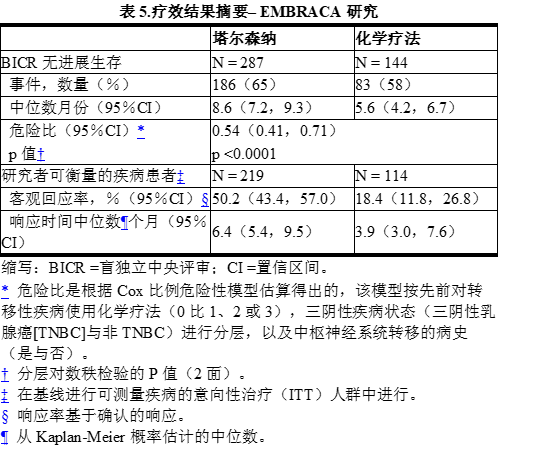
图1. PFS的Kaplan-Meier曲线– EMBRACA研究
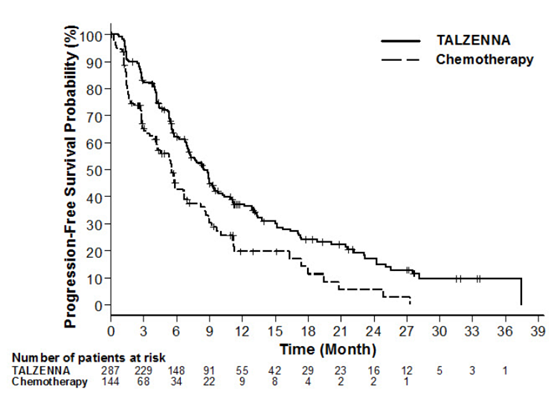
16供应/存储和处理方式
TALZENNA提供的强度和包装配置如表6所述:

存储
存放在20°C至25°C(68°F至77°F); 在15°C至30°C(59°F至86°F)之间允许偏移。
17患者咨询信息
建议患者阅读FDA批准的患者标签(患者信息)。
- MDS / AML:如果患者出现虚弱,感到疲倦,发烧,体重减轻,频繁感染,瘀伤,容易出血,呼吸困难,尿液或粪便中的血液和/或实验室检查到的低血细胞计数,建议患者与医疗保健提供者联系,或者需要输血。这可能是血液学毒性的征兆或称为MDS或AML的更为严重的罕见骨髓问题,已在接受PARP抑制剂的患者中报道[见警告和注意事项(5.1) ]。
- 骨髓抑制:建议患者TALZENNA可能会影响造血功能,并可能导致贫血,白细胞减少/中性粒细胞减少和/或血小板减少症[见警告和注意事项(5.2) ]。
- 给药说明:建议患者每天服用含或不含食物的TALZENNA。指导患者如果错过了TALZENNA剂量,则应在平时服用下一次正常剂量。还建议患者吞下整个胶囊,并且不得将胶囊打开或溶解[见剂量和用法(2.2) ]。
- 胚胎-胎儿毒性:建议女性告知其怀孕或怀孕的医疗人员。告知女性患者胎儿的风险和潜在的怀孕损失[请参见“ 在特定人群中使用(8.1) ”。劝告有生殖潜力的女性在使用TALZENNA治疗期间以及末次给药后至少7个月内使用有效的避孕方法。建议具有生育潜力的女性伴侣或怀孕的男性患者在治疗期间以及在接受最后剂量的TALZENNA 后至少4个月内使用有效避孕措施[请参阅警告和注意事项(5.3),在特定人群中使用(8.1,8.3) ]。
- 哺乳期:建议患者在服用TALZENNA期间以及在接受最后一剂药物后至少1个月内不要母乳喂养[见在特定人群中使用(8.2) ]。
该产品的标签可能已更新。有关当前的完整处方信息,请访问www.talzenna.com。
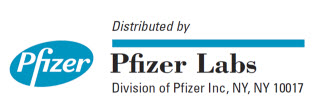
LAB-1271-2.0
患者信息
TALZENNA ™(Tal-ZEN-ah)
(talazoparib)
胶囊我应该了解有关TALZENNA的最重要信息是什么?
TALZENNA可能会引起严重的副作用,包括:
称为骨髓增生异常综合症(MDS)或急性髓性白血病(AML)的骨髓问题。一些患有癌症并曾接受过化疗或某些其他药物治疗过的癌症患者在使用TALZENNA治疗期间或之后已发展为MDS或AML 。MDS或AML可能导致死亡。如果您开发MDS或AML,您的医疗保健提供者将停止使用TALZENNA的治疗。TALZENNA
治疗期间血细胞计数低的症状很常见,但这可能是严重问题的迹象,包括MDS或AML。告诉您的医护人员在使用TALZENNA治疗期间是否有以下任何症状:- 弱点
- 减肥
- 发热
- 频繁感染
- 频繁感染尿液或粪便中的血液
- 呼吸急促
- 感觉很累
- 更容易瘀伤或出血
您的医疗保健提供者将进行血液检查以检查您的血细胞计数:
- 用TALZENNA治疗之前
- TALZENNA治疗期间每个月
- 如果您的血细胞计数持续时间很长,则每周一次。您的医疗保健提供者可能会停止使用TALZENNA的治疗,直到您的血细胞计数增加为止。
请参阅“ 什么是可能的副作用TALZENNA? ”下面的其他副作用TALZENNA。
什么是TALZENNA?
TALZENNA是一种处方药,用于治疗成年人:- 某种类型的乳腺癌(人类表皮生长因子受体2 [HER2]阴性),以及
- 一个异常的遗传BRCA基因,以及
- 其癌症已扩散到身体的其他部位(局部晚期或转移性)。
您的医疗保健提供者将进行测试,以确保TALZENNA适合您。
目前尚不清楚TALZENNA对儿童是否安全有效。服用TALZENNA之前,请告知您的医疗保健提供者所有您的医疗状况,包括您是否:
- 有肾脏问题
- 正在怀孕或打算怀孕。TALZENNA可能会伤害未出生的婴儿,并可能导致流产。使用TALZENNA治疗期间,您不应怀孕。如果您是孕妇或在使用TALZENNA治疗期间怀孕,请立即告知您的医疗保健提供者。
○ 如果您能够怀孕,您的医疗服务提供者可能会在您开始使用TALZENNA治疗之前进行妊娠试验。
○ 能够怀孕的女性应在接受TALZENNA治疗期间以及接受最后一剂TALZENNA后至少7个月内使用有效的节育(避孕)方法。与您的医疗保健提供者讨论可能适合您的节育形式。
○ 男性或女性伴侣已怀孕或即将怀孕的男性,在用TALZENNA治疗期间和接受最后剂量TALZENNA后至少4个月内应使用有效的避孕方法。
- 正在母乳喂养或计划母乳喂养。不知道TALZENNA是否会进入母乳。在使用TALZENNA治疗期间以及接受最后一剂TALZENNA后至少1个月内请勿母乳喂养。与您的医疗保健提供者谈谈这段时间内喂养婴儿的最佳方法。
告诉您的医疗保健提供者您服用的所有药物,包括处方药,非处方药,维生素和草药补品。服用TALZENNA和某些其他药物可能会影响TALZENNA的工作方式并可能引起副作用。
知道你吃的药。保留您的药物清单,并在购买新药时向您的医疗保健提供者和药剂师展示。我应该如何服用TALZENNA?
- 完全按照您的医疗保健人员告诉您的方式服用TALZENNA。
- 在未事先与医疗服务提供者交谈之前,请勿更改剂量或停止服用TALZENNA。
- 每天服用TALZENNA 1次。
- 吃或不吃食物时服用塔尔森纳。
- 燕子TALZENNA胶囊的整体。请勿溶解或打开TALZENNA胶囊。
- 您的医疗保健提供者可能会改变您的TALZENNA剂量,或告诉您停止服用TALZENNA,具体取决于您对治疗的反应方式。
- 如果错过了一次剂量的TALZENNA或呕吐物,请在常规时间服用下一次剂量。不要服用额外的剂量来弥补错过的剂量。
- 如果您服用过多的TALZENNA,请致电您的医疗保健提供者或立即去最近的医院急诊室。
TALZENNA可能有哪些副作用?
TALZENNA可能会导致严重的副作用,包括:
“见什么是我应该知道的最重要的信息TALZENNA? ”
的最常见的副作用TALZENNA包括:- 疲倦或虚弱
- 红细胞或白细胞数量少
- 恶心
- 血小板数量少
- 头痛
- 头痛食欲不振
- 腹泻
- 呕吐
- 脱发
TALZENNA可能导致男性生育问题。这可能会影响您生孩子的能力。如果您担心此问题,请与您的医疗保健提供者联系。这些并不是TALZENNA的所有可能的副作用。
打电话给您的医生,征求有关副作用的医疗建议。您可以通过1-800-FDA-1088向FDA报告副作用。我应该如何存放TALZENNA?
将TALZENNA储存在68°F至77°F(20°C至25°C)下。
将TALZENNA和所有药物放在儿童接触不到的地方。有关安全有效使用TALZENNA的一般信息。
有时出于患者信息手册中列出的目的以外的目的开出处方药。请勿在没有规定的条件下使用TALZENNA。即使他人有与您相同的症状,也不要将TALZENNA给予他人。可能会伤害他们。您可以询问您的医疗保健提供者或药剂师,以获取有关为卫生专业人员编写的有关TALZENNA的信息。TALZENNA中有哪些成分?
活性成分:甲苯磺酸他拉唑帕
非活性成分:硅化微晶纤维素(sMCC)。白色和象牙色以及白色和浅红色的不透明胶囊壳包含羟丙甲纤维素(HPMC),黄色氧化铁,红色氧化铁和二氧化钛。印刷油墨包含虫胶,黑色氧化铁,氢氧化钾,氢氧化铵和丙二醇。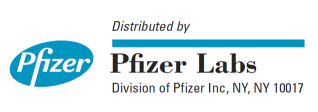
有关更多信息,请访问www。TALZENNA .com或致电1-800-438-1985。
LAB-1272-1.0该患者信息已获得美国食品和药物管理局的批准。
发行于10/2018
主要显示面板-0.25毫克胶囊瓶标签
辉瑞
NDC 0069-0296-30
Talzenna ™
(他唑帕尼)胶囊0.25毫克
仅30粒胶囊
主要显示面板-0.25毫克胶囊瓶纸箱
辉瑞
NDC 0069-0296-30
Talzenna ™
(他唑帕尼)
胶囊0.25毫克
仅30粒胶囊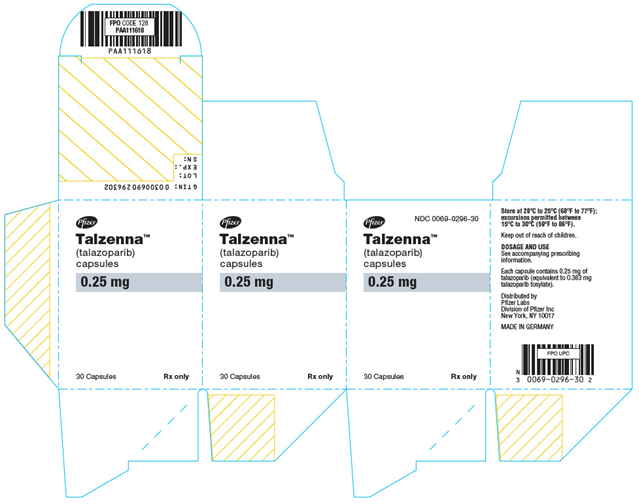
主要显示面板-1毫克胶囊瓶标签
辉瑞
NDC 0069-1195-30
Talzenna ™
(他唑帕尼)胶囊1毫克
仅30粒胶囊
主要显示面板-1毫克胶囊瓶纸箱
辉瑞
NDC 0069-1195-30
Talzenna ™
(他唑帕尼)
胶囊1毫克
仅30粒胶囊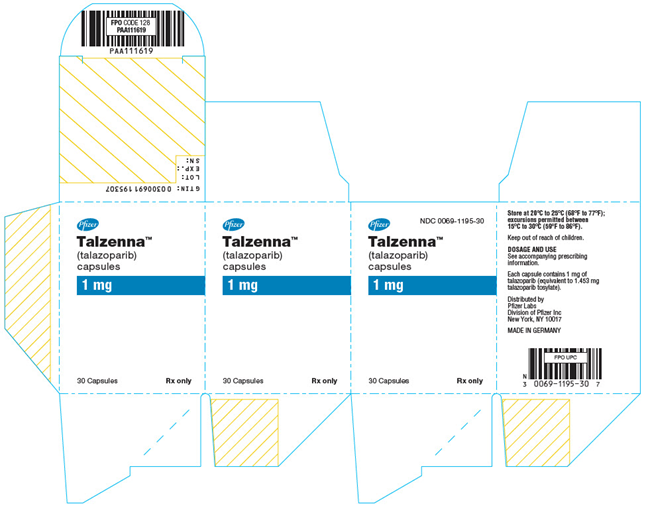
【备注】以上内容仅供参考,不作为用药依据,详情请参照药品附带说明书。
-
本说明书来源于:美国FDA
https://nctr-crs.fda.gov/fdalabel/services/spl/set-ids/f2423edd-6d24-495c-aec1-c2f457f08d9a/spl-doc?hl=Talzenna
温馨提醒:
①建议您用 谷歌浏览器 在电脑上或手机 打开以上链接,就可以自动翻译成简体中文,而且翻译的还比较准确。
②本说明书仅供参考,最新的说明书详见药品附带的说明书。
FULL PRESCRIBING INFORMATION
1 INDICATIONS AND USAGE
TALZENNA is indicated for the treatment of adult patients with deleterious or suspected deleterious germline breast cancer susceptibility gene (BRCA)-mutated (gBRCAm) human epidermal growth factor receptor 2 (HER2)-negative locally advanced or metastatic breast cancer. Select patients for therapy based on an FDA-approved companion diagnostic for TALZENNA [see Dosage and Administration (2.1)].
2 DOSAGE AND ADMINISTRATION
2.1 Patient Selection
Select patients for the treatment of advanced breast cancer with TALZENNA based on the presence of germline BRCA mutations [see Indications and Usage (1), Clinical Studies (14)]. Information on the FDA-approved test for the detection of BRCA mutations is available at http://www.fda.gov/companiondiagnostics.
2.2 Recommended Dosing
The recommended dose of TALZENNA is 1 mg taken orally once daily, with or without food.
The 0.25 mg capsule is available for dose reduction.
Patients should be treated until disease progression or unacceptable toxicity occurs.
The hard capsules should be swallowed whole and must not be opened or dissolved. If the patient vomits or misses a dose, an additional dose should not be taken. The next prescribed dose should be taken at the usual time.
2.3 Dose Modifications for Adverse Reactions
To manage adverse reactions, consider interruption of treatment with or without dose reduction based on severity and clinical presentation. Recommended dose reductions are indicated in Table 1 and Table 2. Treatment with TALZENNA should be discontinued if more than three dose reductions are required.
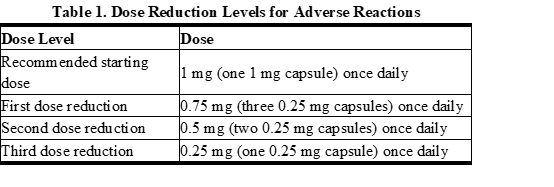
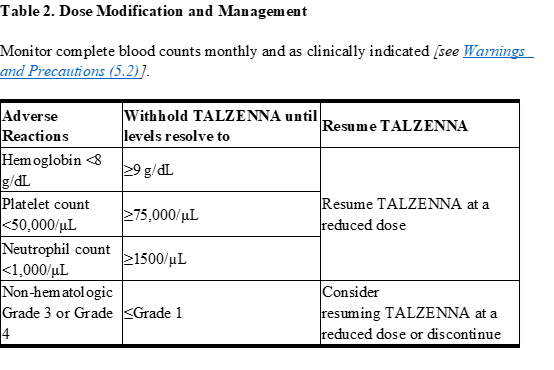
2.4 Dose Modifications for Patients with Renal Impairment
For patients with moderate renal impairment (CLcr 30 – 59 mL/min), the recommended dose of TALZENNA is 0.75 mg once daily [see Use in Specific Populations (8.6), Clinical Pharmacology (12.3)].
2.5 Dose Modifications for Use with P-glycoprotein (P-gp) Inhibitors
Reduce the TALZENNA dose to 0.75 mg once daily when coadministered with certain P-gp inhibitors. For additional information on interacting P-gp inhibitors, see Drug Interactions (7.1) and Clinical Pharmacology (12.3).
When the P-gp inhibitor is discontinued, increase the TALZENNA dose (after 3–5 half-lives of the P-gp inhibitor) to the dose used prior to the initiation of the P-gp inhibitor [see Drug Interactions (7.1), Clinical Pharmacology (12.3)].
3 DOSAGE FORMS AND STRENGTHS
Capsules:
- 0.25 mg capsule with an ivory cap (printed with "Pfizer" in black) and a white body (printed with "TLZ 0.25" in black)
- 1 mg capsule with a light red cap (printed with "Pfizer" in black) and a white body (printed with "TLZ 1" in black)
4 CONTRAINDICATIONS
None.
5 WARNINGS AND PRECAUTIONS
5.1 Myelodysplastic Syndrome/Acute Myeloid Leukemia
Myelodysplastic Syndrome/Acute Myeloid Leukemia (MDS/AML) have been reported in patients who received TALZENNA. Overall, MDS/AML has been reported in 2 out of 584 (0.3%) solid tumor patients treated with TALZENNA in clinical studies. The duration of TALZENNA treatment in these two patients prior to developing MDS/AML was 4 months and 24 months, respectively. Both patients had received previous chemotherapy with platinum agents and/or other DNA damaging agents including radiotherapy.
Do not start TALZENNA until patients have adequately recovered from hematological toxicity caused by previous chemotherapy. Monitor complete blood counts for cytopenia at baseline and monthly thereafter. For prolonged hematological toxicities, interrupt TALZENNA and monitor blood counts weekly until recovery. If the levels have not recovered after 4 weeks, refer the patient to a hematologist for further investigations, including bone marrow analysis and blood sample for cytogenetics. If MDS/AML is confirmed, discontinue TALZENNA.
5.2 Myelosuppression
Myelosuppression consisting of anemia, leukopenia/neutropenia, and/or thrombocytopenia, have been reported in patients treated with TALZENNA [see Adverse Reactions (6)]. Grade ≥3 anemia, neutropenia, and thrombocytopenia were reported, respectively, in 39%, 21%, and 15% of patients receiving TALZENNA. Discontinuation due to anemia, neutropenia, and thrombocytopenia occurred, respectively, in 0.7%, 0.3%, and 0.3% of patients.
Monitor complete blood count for cytopenia at baseline and monthly thereafter. Do not start TALZENNA until patients have adequately recovered from hematological toxicity caused by previous therapy. If this occurs, dose modifications (dosing interruption with or without dose reduction) are recommended [see Dosing Modifications (2.3)].
5.3 Embryo-Fetal Toxicity
Based on its mechanism of action and findings from animal data, TALZENNA can cause fetal harm when administered to a pregnant woman. In an animal reproduction study, administration of talazoparib to pregnant rats during the period of organogenesis caused fetal malformations and structural skeletal variations, and embryo-fetal death at exposures that were 0.24 times the area under the concentration-time curve (AUC) in patients receiving the recommended human dose of 1 mg daily. Apprise pregnant women and females of reproductive potential of the potential risk to a fetus. Advise females of reproductive potential to use effective contraception during treatment and for at least 7 months following the last dose of TALZENNA [see Use in Specific Populations (8.1, 8.3), Clinical Pharmacology (12.1)].
Based on findings from genetic toxicity and animal reproduction studies, advise male patients with female partners of reproductive potential or who are pregnant to use effective contraception during treatment and for at least 4 months following the last dose of TALZENNA [see Use in Specific Populations (8.1, 8.3), Nonclinical Toxicology (13.1)].
6 ADVERSE REACTIONS
The following clinically significant adverse reactions are described elsewhere in the labeling:
- Myelodysplastic Syndrome/Acute Myeloid Leukemia [see Warnings and Precautions (5.1)]
- Myelosuppression [see Warnings and Precautions (5.2)]
6.1 Clinical Trials Experience
Because clinical trials are conducted under widely varying conditions, adverse reaction rates observed in the clinical trials of a drug cannot be directly compared to rates in the clinical trials of another drug and may not reflect the rates observed in practice.
Treatment of gBRCAm HER2-negative Locally Advanced or Metastatic Breast Cancer
EMBRACA
The safety of TALZENNA as monotherapy was evaluated in gBRCAm patients with HER2-negative locally advanced or metastatic breast cancer who had previously received no more than 3 lines of chemotherapy for the treatment of locally advanced/metastatic disease. EMBRACA was a randomized, open-label, multi-center study in which 412 patients received either TALZENNA 1 mg once daily (n=286) or a chemotherapy agent (capecitabine, eribulin, gemcitabine, or vinorelbine) of the healthcare provider's choice (n=126) until disease progression or unacceptable toxicity. The median duration of study treatment was 6.1 months in patients who received TALZENNA and 3.9 months in patients who received chemotherapy. Dosing interruptions due to an adverse reaction of any grade occurred in 65% of patients receiving TALZENNA and 50% of those receiving chemotherapy; dose reductions due to any cause occurred in 53% of TALZENNA patients and 40% of chemotherapy patients. Permanent discontinuation due to adverse reactions occurred in 5% of TALZENNA patients and 6% chemotherapy patients.
Table 3 and Table 4 summarize the most common adverse reactions and laboratory abnormalities, respectively, in patients treated with TALZENNA or chemotherapy in the EMBRACA study.
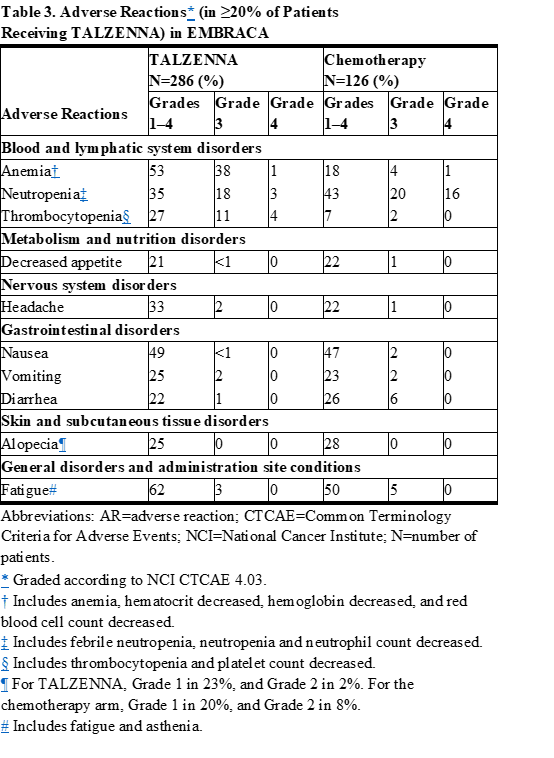
The following adverse reactions have been identified in <20% of the 286 patients receiving TALZENNA, and thus were not included in Table 3: abdominal pain (19%), dizziness (17%), leukopenia (17%), dysgeusia (10%), dyspepsia (10%), stomatitis (8%), and lymphopenia (7%).
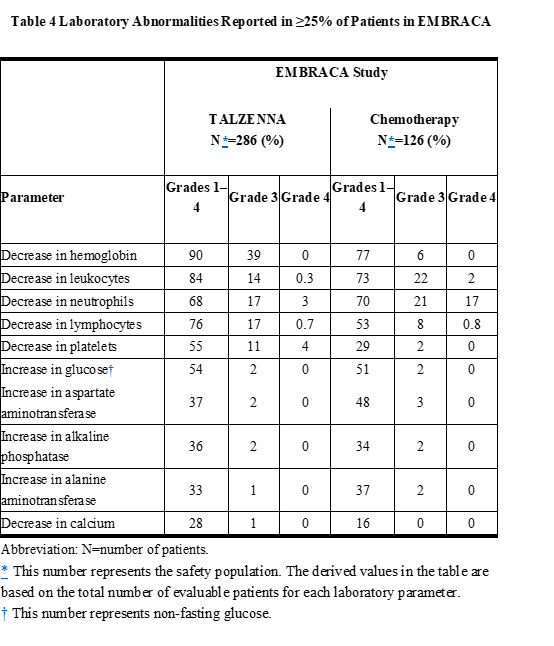
7 DRUG INTERACTIONS
7.1 Effect of Other Drugs on TALZENNA
Effect of P-gp Inhibitors
Coadministration with P-gp inhibitors may increase talazoparib exposure.
In patients with advanced solid tumors, coadministration of a P-gp inhibitor (itraconazole) increased talazoparib plasma exposure by 56%. In the clinical studies, coadministration with P-gp inhibitors including amiodarone, carvedilol, clarithromycin, itraconazole, and verapamil resulted in an approximate 45% increase in talazoparib exposure and an increase in the rate of TALZENNA dose reduction. If coadministration of TALZENNA with these P-gp inhibitors cannot be avoided, reduce the TALZENNA dose [see Dosage and Administration (2.5)]. When the P-gp inhibitor is discontinued, increase the TALZENNA dose (after 3–5 half-lives of the inhibitor) to the dose used prior to the initiation of the P-gp inhibitor [see Dosage and Administration (2.5), Clinical Pharmacology (12.3)].
When coadministering TALZENNA with P-gp inhibitors not listed above, monitor patients for potential increased adverse reactions [see Dosage and Administration (2.5), Clinical Pharmacology (12.3)].
Effect of BCRP inhibitors
Coadministration with BCRP inhibitors may increase talazoparib exposure. If coadministration cannot be avoided, monitor patients for potential increased adverse reactions when coadministering [see Clinical Pharmacology (12.3)].
8 USE IN SPECIFIC POPULATIONS
8.1 Pregnancy
Risk Summary
Based on findings from animal studies and its mechanism of action [see Clinical Pharmacology (12.1)], TALZENNA can cause embryo-fetal harm when administered to a pregnant woman. There are no available data on TALZENNA use in pregnant women to inform a drug-associated risk. In an animal reproduction study, the administration of talazoparib to pregnant rats during the period of organogenesis caused fetal malformations and structural skeletal variations and embryo-fetal death at maternal exposures that were 0.24 times the AUC in patients receiving the recommended dose of 1 mg daily (see Data). Apprise pregnant women and females of reproductive potential of the potential risk to a fetus.
The background risk of major birth defects and miscarriage for the indicated population is unknown. In the general U.S. population, the estimated background risks of major birth defects and miscarriage in clinically recognized pregnancies are 2% to 4% and 15% to 20%, respectively.
Data
Animal Data
In an embryo-fetal development toxicity study, pregnant rats received oral doses of 0.015, 0.05, and 0.15 mg/kg/day talazoparib during the period of organogenesis. Talazoparib caused embryo-fetal death at doses ≥0.015 mg/kg/day (approximately 0.24 times the AUC in patients at the recommended dose). A dose of 0.015 mg/kg/day caused decreased fetal body weights and an increased incidence of fetal malformations (depressed eye bulge, small eye, split sternebra, and fused cervical vertebral arch) and structural variations including misshapen or incomplete ossification of the sternebra, skull, rib, and vertebra.
8.2 Lactation
Risk Summary
There are no data on the presence of talazoparib in human milk, the effects of the drug on milk production, or the effects of the drug on the breastfed child. Because of the potential for serious adverse reactions in a breastfed child from talazoparib, advise lactating women not to breastfeed during treatment with TALZENNA and for at least 1 month after the final dose.
8.3 Females and Males of Reproductive Potential
Pregnancy Testing
A pregnancy test is recommended for females of reproductive potential prior to initiating TALZENNA treatment.
Contraception
Females
TALZENNA can cause fetal harm when administered to pregnant women [see Use in Specific Populations (8.1)]. Advise females of reproductive potential to use effective contraception during treatment and for at least 7 months following the last dose of TALZENNA.
Males
Based on genotoxicity and animal reproduction studies, advise male patients with female partners of reproductive potential and pregnant partners to use effective contraception during treatment with TALZENNA and for at least 4 months following the last dose [see Use in Specific Populations (8.1), Nonclinical Toxicology (13.1)].
Infertility
Males
Based on animal studies, TALZENNA may impair fertility in males of reproductive potential [see Nonclinical Toxicology (13.1)].
8.4 Pediatric Use
The safety and effectiveness of TALZENNA have not been established in pediatric patients.
8.5 Geriatric Use
In clinical trials of TALZENNA enrolling 494 patients with advanced solid tumors who received TALZENNA 1 mg daily as monotherapy, 85 (17%) patients were ≥65 years of age, and this included 19 (4%) patients who were ≥75 years old. There were 5 patients ≥85 years old. No overall differences in safety or effectiveness of TALZENNA were observed between these patients and younger patients, but greater sensitivity of some older individuals cannot be ruled out.
8.6 Renal Impairment
Reduce the recommended dose of TALZENNA in patients with moderate renal impairment (CLcr 30 – 59 mL/min) [see Dosage and Administration (2.4), Clinical Pharmacology (12.3)]. No dose adjustment is required for patients with mild renal impairment (CLcr 60 – 89 mL/min). TALZENNA has not been studied in patients with severe renal impairment (CLcr < 30 mL/min) or patients requiring hemodialysis [see Clinical Pharmacology (12.3)].
8.7 Hepatic Impairment
TALZENNA has not been studied in patients with moderate hepatic impairment (total bilirubin >1.5 to 3.0 × upper limit of normal [ULN] and any aspartate aminotransferase [AST]) or severe hepatic impairment (total bilirubin >3.0 × ULN and any AST). No dose adjustment is required for patients with mild hepatic impairment (total bilirubin ≤1 × ULN and AST > ULN, or total bilirubin >1.0 to 1.5 × ULN and any AST) [see Clinical Pharmacology (12.3)].
10 OVERDOSAGE
There is no specific treatment in the event of TALZENNA overdose, and symptoms of overdose have not been established. In the event of overdose, discontinue treatment with TALZENNA, consider gastric decontamination, follow general supportive measures, and treat symptomatically.
11 DESCRIPTION
Talazoparib is an inhibitor of mammalian polyadenosine 5'-diphosphoribose polymerase (PARP) enzyme. The chemical name of talazoparib tosylate is (8S,9R)-5-Fluoro-8-(4-fluorophenyl)-9-(1-methyl-1H-1,2,4-triazol-5-yl)-2,7,8,9-tetrahydro-3H-pyrido[4,3,2-de]phthalazin-3-one 4-methylbenzenesulfonate (1:1). The chemical formula of talazoparib tosylate is C26H22F2N6O4S, and the relative molecular mass is 552.56 Daltons. The chemical structure of talazoparib tosylate is shown below:
Talazoparib tosylate is a white to yellow solid. TALZENNA capsules for oral use are available as a 0.25 mg hard hypromellose (HPMC) capsule that contains 0.363 mg talazoparib tosylate equivalent to 0.25 mg talazoparib free base or as a 1 mg HPMC capsule that contains 1.453 mg talazoparib tosylate equivalent to 1 mg talazoparib free base.
Inactive ingredients: silicified microcrystalline cellulose (sMCC). The white/ivory and white/light red opaque capsule shells contain HPMC, yellow iron oxide, red iron oxide and titanium dioxide; and the printing ink contains shellac, black iron oxide, potassium hydroxide, ammonium hydroxide, and propylene glycol.
12 CLINICAL PHARMACOLOGY
12.1 Mechanism of Action
Talazoparib is an inhibitor of poly (ADP-ribose) polymerase (PARP) enzymes, including PARP1 and PARP2, which play a role in DNA repair. In vitro studies with cancer cell lines that harbored defects in DNA repair genes, including BRCA 1 and 2, have shown that talazoparib-induced cytotoxicity may involve inhibition of PARP enzymatic activity and increased formation of PARP-DNA complexes resulting in DNA damage, decreased cell proliferation, and apoptosis. Talazoparib anti-tumor activity was observed in human patient-derived xenograft breast cancer tumor models that expressed mutated or wild-type BRCA 1 and 2.
12.2 Pharmacodynamics
Cardiac Electrophysiology
The effect of talazoparib on cardiac repolarization was evaluated in 37 patients with advanced solid tumors. Talazoparib had no large QTc prolongation (i.e., >20 ms) at the recommended dose.
12.3 Pharmacokinetics
After oral administration of 1 mg TALZENNA once daily in patients, the recommended dose, the geometric mean [% coefficient of variation (CV%)] of AUC and maximum observed plasma concentration (Cmax) of talazoparib at steady-state was 208 (37%) ng.hr/mL and 16.4 (32%) ng/mL, respectively. The pharmacokinetics (PK) of talazoparib is linear from 0.025 mg to 2 mg (2 times the recommended dose). The median accumulation ratio of talazoparib following repeated oral administration of 1 mg once daily was in the range of 2.3 to 5.2. Talazoparib plasma concentrations reached steady-state within 2 to 3 weeks.
Absorption
Following oral administration of talazoparib, the median time to Cmax (Tmax) was generally between 1 to 2 hours after dosing.
Food Effect
Following a single oral dose of 0.5 mg TALZENNA with high-fat, high-calorie food (approximately 800 to 1000 calories with 150, 250, and 500 to 600 calories from protein, carbohydrate, and fat, respectively), the mean Cmax of talazoparib was decreased by 46%, the median Tmax was delayed from 1 to 4 hours, and AUCinf was not affected.
Distribution
The mean apparent volume of distribution of talazoparib is 420 L. In vitro, protein binding of talazoparib is 74% and is independent of talazoparib concentration.
Elimination
The mean terminal plasma half-life (±standard deviation) of talazoparib is 90 (±58) hours, and the mean apparent oral clearance (inter-subject variability) is 6.45 L/h (31.1%) in cancer patients.
Metabolism
Talazoparib undergoes minimal hepatic metabolism. The identified metabolic pathways of talazoparib in humans include mono-oxidation, dehydrogenation, cysteine conjugation of mono-desfluoro-talazoparib, and glucuronide conjugation.
Excretion
Excretion of talazoparib in urine was the major route of elimination. Approximately 68.7% (54.6% unchanged) of the total administered radioactive dose [14C]talazoparib was recovered in urine, and 19.7% (13.6% unchanged) was recovered in feces.
Specific Populations
Age (18 to 88 years), sex, race (361 White, 41 Asian, 16 Black, 9 Others, and 63 Not Reported), and body weight (36 to 162 kg) had no clinically relevant effect on the PK of talazoparib.
Pediatric Patients
The pharmacokinetics of talazoparib have not been evaluated in patients <18 years of age.
Patients with Renal Impairment
Talazoparib CL/F was decreased by 14.4% in patients with mild renal impairment (CLcr 60 – 89 mL/min) and 37.1% in patients with moderate renal impairment (CLcr 30 – 59 mL/min), when compared to patients with normal renal function (CLcr ≥ 90 mL/min). The PK of talazoparib have not been studied in patients with severe renal impairment (CLcr < 30 mL/min) or in patients requiring hemodialysis.
Patients with Hepatic Impairment
Mild hepatic impairment (total bilirubin ≤1.0 × ULN and AST > ULN, or total bilirubin >1.0 to 1.5 × ULN and any AST) had no effect on the PK of talazoparib. The PK of talazoparib have not been studied in patients with moderate (total bilirubin >1.5 to 3.0 × ULN and any AST) or severe hepatic impairment (total bilirubin >3.0 × ULN and any AST).
Drug Interaction Studies
Effect of Other Drugs on Talazoparib
Effect of P-gp inhibitors: In patients with advanced solid tumors, coadministration of a P-gp inhibitor (multiple 100 mg twice-daily doses of itraconazole) with a single 0.5 mg talazoparib dose increased talazoparib AUCinf and Cmax by approximately 56% and 40%, respectively. Population PK analysis showed that coadministration with P-gp inhibitors including amiodarone, carvedilol, clarithromycin, itraconazole, and verapamil in clinical studies increased talazoparib exposure by 45% [see Dosage and Administration (2.5), Drug Interactions (7.1)].
Coadministration with P-gp inhibitors including azithromycin, atorvastatin, diltiazem, felodipine, fluvoxamine, and quercetin in clinical studies increased talazoparib exposure by 8% [see Dosage and Administration (2.5), Drug Interactions (7)].
Effect of P-gp inducers: In patients with advanced solid tumors, coadministration of a P-gp inducer (multiple 600 mg once-daily doses of rifampin) with a single 1 mg talazoparib dose increased talazoparib Cmax by 37% with no effect on talazoparib exposure.
Effect of BCRP inhibitors: The effect of BCRP inhibitors on PK of talazoparib has not been studied. Coadministration with BCRP inhibitors may increase talazoparib exposure [see Drug Interactions (7)].
Effect of acid-reducing agents on talazoparib: Coadministration of acid-reducing agents including proton pump inhibitors (PPI), histamine receptor 2 antagonists (H2RA), or other acid reducing agents has no effect on the absorption of talazoparib.
In Vitro Studies
Talazoparib is a substrate of P-gp and BCRP transporters.
Talazoparib is not a substrate of organic anion transporting polypeptide [OATP]1B1, OATP1B3, organic cationic transporter [OCT]1, OCT2, organic anion transporter [OAT]1, OAT3, bile salt export pump [BSEP], multidrug and toxin extrusion [MATE]1, and MATE2-K.
Talazoparib is not an inhibitor of cytochrome (CYP)1A2, CYP2B6, CYP2C8, CYP2C9, CYP2C19, CYP2D6, or CYP3A4/5, or inducer of CYP1A2, CYP2B6, or CYP3A4.
Talazoparib is not an inhibitor of transporters including P-gp, BCRP, OATP1B1, OATP1B3, OCT1, OCT2, OAT1, OAT3, BSEP, MATE1, and MATE2-K.
Talazoparib is not an inhibitor of uridine-diphosphate glucuronosyltransferase (UGT) isoforms (1A1, 1A4, 1A6, 1A9, 2B7, and 2B15).
13 NONCLINICAL TOXICOLOGY
13.1 Carcinogenesis, Mutagenesis, Impairment of Fertility
Carcinogenicity studies have not been conducted with talazoparib.
Talazoparib was clastogenic in an in vitro chromosomal aberration assay in human peripheral blood lymphocytes and in an in vivo bone marrow micronucleus assay in rats. This clastogenicity is consistent with genomic instability resulting from the primary pharmacology of talazoparib, indicating the potential for genotoxicity in humans. Talazoparib was not mutagenic in a bacterial reverse mutation (Ames) test.
Fertility studies in animals have not been conducted with talazoparib. In repeat-dose toxicity studies up to 3-months duration, talazoparib-related findings in the testis and epididymis at doses ≥0.04 mg/kg/day in rats and ≥0.01 mg/kg/day in dogs included decreased organ weights, luminal cellular debris, reduced sperm, and degeneration/atrophy. These doses in rats and dogs resulted in approximately 1.0 times and 0.2 times, respectively, the exposure (AUC) in humans at the recommended dose. Follicular atresia of the ovary was observed in rats at doses ≥1 mg/kg/day talazoparib, approximately 9.5 times the AUC in patients at the recommended dose.
14 CLINICAL STUDIES
EMBRACA Study (NCT01945775)
Deleterious or Suspected Deleterious Germline BRCA-mutated (gBRCAm) HER2-negative Locally Advanced or Metastatic Breast Cancer
EMBRACA (NCT01945775) was an open-label study in which patients (N=431) with gBRCAm HER2-negative locally advanced or metastatic breast cancer were randomized 2:1 to receive TALZENNA 1 mg or healthcare provider's choice of chemotherapy (capecitabine, eribulin, gemcitabine, or vinorelbine) until disease progression or unacceptable toxicity. Randomization was stratified by prior use of chemotherapy for metastatic disease (0 versus 1, 2, or 3), by triple-negative disease status (triple-negative breast cancer [TNBC] versus non-TNBC), and history of central nervous system (CNS) metastasis (yes versus no).
Patients received no more than 3 prior cytotoxic chemotherapy regimens for their metastatic or locally advanced disease. Patients were required to have received treatment with an anthracycline and/or a taxane (unless contraindicated) in the neoadjuvant, adjuvant, and/or metastatic treatment setting. First-line treatment for advanced or metastatic disease with no prior adjuvant chemotherapy was allowed if the investigator determined that 1 of the 4 chemotherapy choices in the control arm would be an appropriate treatment option for the patient. Patients with prior platinum therapy for advanced disease were required to have no evidence of disease progression during platinum therapy. No prior treatment with a PARP inhibitor was permitted. Of the 431 patients randomized in the EMBRACA study, 408 (95%) were centrally confirmed to have a deleterious or suspected deleterious gBRCAm using a clinical trial assay; out of which 354 (82%) were confirmed using the BRACAnalysis CDx®. BRCA mutation status (breast cancer susceptibility gene 1 [BRCA1] positive or breast cancer susceptibility gene 2 [BRCA2] positive) was similar across both treatment arms.
The median age of patients treated with TALZENNA was 45 years (range 27 to 84) and 50 years (range 24 to 88) among patients treated with chemotherapy. Among all randomized patients, 1% versus 2% were males, 67% versus 75% were White; 11% versus 11% were Asian, and 4% versus 1% were Black or African American in the TALZENNA and chemotherapy arms, respectively. Almost all patients (98%) in both arms had an Eastern Cooperative Oncology Group (ECOG) performance status of 0 or 1. Approximately 56% of patients had estrogen receptor-positive and/or progesterone receptor-positive disease; 44% of patients had triple-negative disease, and the proportions were balanced across both treatment arms. Fifteen percent (15%) of patients in the TALZENNA arm and 14% of patients in the chemotherapy arm had a history of CNS metastases. Ninety-one percent (91%) of patients in the TALZENNA arm had received prior taxane therapy, and 85% had received prior anthracycline therapy in any setting. Sixteen percent (16%) of patients in the TALZENNA arm and 21% of patients in the chemotherapy arm had received prior platinum treatment in any setting. The median number of prior cytotoxic regimens for patients with advanced breast cancer was one; 38% received no prior cytotoxic regimens for advanced or metastatic disease, 37% received one, 20% received two, and 5% received three or more prior cytotoxic regimens.
The major efficacy outcome measure was progression-free survival (PFS) evaluated according to Response Evaluation Criteria in Solid Tumors (RECIST) version 1.1, as assessed by blinded independent central review (BICR). A statistically significant improvement in PFS was demonstrated for TALZENNA compared with chemotherapy. A sensitivity analysis of investigator-assessed PFS was consistent with the BICR-assessed PFS results. Consistent PFS results were observed across patient subgroups defined by study stratification factors (line of therapy, TNBC status, and history of CNS metastases). The overall survival (OS) data were not mature at the time of the final PFS analysis (38% of patients had died). Efficacy data from the EMBRACA study are summarized in Table 5, and the Kaplan-Meier curves for PFS are shown in Figure 1.
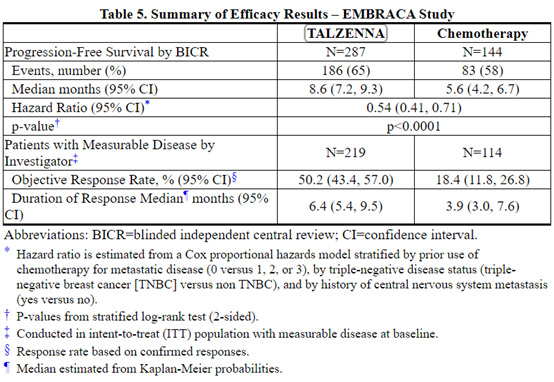
Figure 1. Kaplan-Meier Curves of PFS – EMBRACA Study
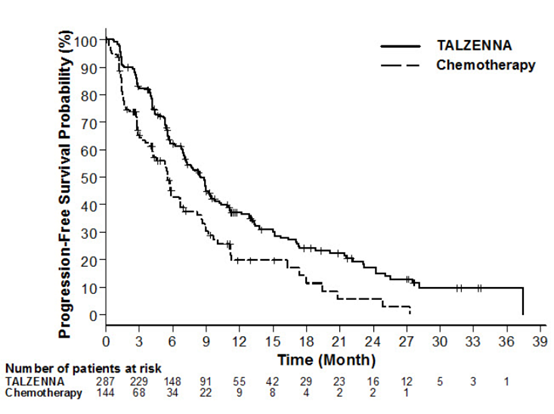
16 HOW SUPPLIED/STORAGE AND HANDLING
TALZENNA is supplied in strengths and package configurations as described in Table 6:
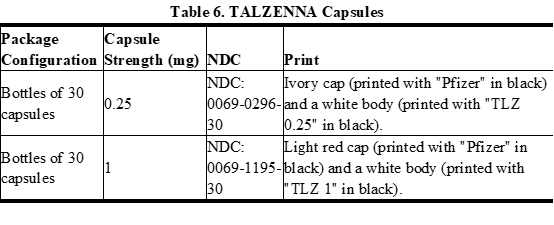
Storage
Store at 20°C to 25°C (68°F to 77°F); excursions permitted between 15°C to 30°C (59°F to 86°F).
17 PATIENT COUNSELING INFORMATION
Advise the patient to read the FDA-approved patient labeling (Patient Information).
- MDS/AML: Advise patients to contact their healthcare provider if they experience weakness, feeling tired, fever, weight loss, frequent infections, bruising, bleeding easily, breathlessness, blood in urine or stool, and/or laboratory findings of low blood cell counts, or a need for blood transfusions. This may be a sign of hematological toxicity or a more serious uncommon bone marrow problem called MDS or AML, which have been reported in patients who received PARP inhibitors [see Warnings and Precautions (5.1)].
- Myelosuppression: Advise patients that TALZENNA may affect hematopoiesis and can cause anemia, leukopenia/neutropenia, and/or thrombocytopenia [see Warnings and Precautions (5.2)].
- Administration Instructions: Advise patients that TALZENNA can be taken once daily with or without food. Instruct patients that if they miss a dose of TALZENNA, they should take their next normal dose at the usual time. Also advise patients to swallow each capsule whole, and that capsules must not be opened or dissolved [see Dosage and Administration (2.2)].
- Embryo-Fetal Toxicity: Advise females to inform their healthcare provider if they are pregnant or become pregnant. Inform female patients of the risk to a fetus and potential loss of the pregnancy [see Use in Specific Populations (8.1)]. Advise females of reproductive potential to use effective contraception during treatment with TALZENNA and for at least 7 months after the last dose. Advise male patients with female partners of reproductive potential or who are pregnant to use effective contraception during treatment and for at least 4 months after receiving the last dose of TALZENNA [see Warnings and Precautions (5.3), Use in Specific Populations (8.1, 8.3)].
- Lactation: Advise patients not to breastfeed while taking TALZENNA and for at least 1 month after receiving the last dose [see Use in Specific Populations (8.2)].
This product's label may have been updated. For current full prescribing information, please visit www.talzenna.com.
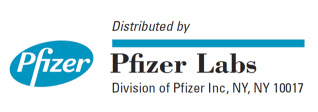
LAB-1271-2.0
PATIENT INFORMATION
TALZENNA™ (Tal-ZEN-ah)
(talazoparib)
capsulesWhat is the most important information I should know about TALZENNA?
TALZENNA may cause serious side effects, including:
Bone marrow problems called Myelodysplastic Syndrome (MDS) or Acute Myeloid Leukemia (AML). Some people who have cancer and who have received previous treatment with chemotherapy or certain other medicines for their cancer have developed MDS or AML during or after treatment with TALZENNA. MDS or AML may lead to death. If you develop MDS or AML, your healthcare provider will stop treatment with TALZENNA.
Symptoms of low blood cell counts are common during treatment with TALZENNA, but can be a sign of serious problems, including MDS or AML. Tell your healthcare provider if you have any of the following symptoms during treatment with TALZENNA:- weakness
- weight loss
- fever
- frequent infections
- blood in urine or stool
- shortness of breath
- feeling very tired
- bruising or bleeding more easily
Your healthcare provider will do blood tests to check your blood cell counts:
- before treatment with TALZENNA
- every month during treatment with TALZENNA
- weekly if you have low blood cell counts that last a long time. Your healthcare provider may stop treatment with TALZENNA until your blood cell counts improve.
See "What are the possible side effects of TALZENNA?" below for other side effects of TALZENNA.
What is TALZENNA?
TALZENNA is a prescription medicine used to treat adults with:- a certain type of breast cancer (human epidermal growth factor receptor 2 [HER2]-negative), and
- an abnormal inherited BRCA gene, and
- whose cancer has spread to other parts of the body (locally advanced or metastatic).
Your healthcare provider will perform a test to make sure that TALZENNA is right for you.
It is not known if TALZENNA is safe and effective in children.Before taking TALZENNA, tell your healthcare provider about all of your medical conditions, including if you:
- have kidney problems
- are pregnant or plan to become pregnant. TALZENNA can harm your unborn baby, and may cause loss of pregnancy (miscarriage). You should not become pregnant during treatment with TALZENNA. Tell your healthcare provider right away if you are pregnant or become pregnant during treatment with TALZENNA.
○If you are able to become pregnant, your healthcare provider may do a pregnancy test before you start treatment with TALZENNA.
○Females who are able to become pregnant should use effective birth control (contraception) during treatment with TALZENNA and for at least 7 months after receiving the last dose of TALZENNA. Talk to your healthcare provider about forms of birth control that may be right for you.
○Males with female partners who are pregnant or are able to become pregnant should use effective birth control during treatment with TALZENNA and for at least 4 months after receiving the last dose of TALZENNA.
- are breastfeeding or plan to breastfeed. It is not known if TALZENNA passes into your breast milk. Do not breastfeed during treatment with TALZENNA and for at least 1 month after receiving the last dose of TALZENNA. Talk to your healthcare provider about the best way to feed your baby during this time.
Tell your healthcare provider about all the medicines you take, including prescription medicines, over-the-counter medicines, vitamins, and herbal supplements. Taking TALZENNA and certain other medicines can affect how TALZENNA works and may cause side effects.
Know the medicines you take. Keep a list of your medicines and show it to your healthcare provider and pharmacist when you get a new medicine.How should I take TALZENNA?
- Take TALZENNA exactly as your healthcare provider tells you.
- Do not change your dose or stop taking TALZENNA without first talking with your healthcare provider.
- Take TALZENNA 1 time a day.
- Take TALZENNA with or without food.
- Swallow TALZENNA capsules whole. Do not dissolve or open TALZENNA capsules.
- Your healthcare provider may change your dose of TALZENNA or tell you to stop taking TALZENNA depending on how you respond to treatment.
- If you miss a dose of TALZENNA or vomit, take your next dose at your regular time. Do not take an extra dose to make up for a missed dose.
- If you take too much TALZENNA, call your healthcare provider or go to the nearest hospital emergency room right away.
What are the possible side effects of TALZENNA?
TALZENNA may cause serious side effects, including:
See "What is the most important information I should know about TALZENNA?"
The most common side effects of TALZENNA include:- tiredness or weakness
- low number of red or white blood cells
- nausea
- low number of platelets
- headache
- loss of appetite
- diarrhea
- vomiting
- hair loss
TALZENNA may cause fertility problems in males. This may affect your ability to father a child. Talk to your healthcare provider if this is a concern for you. These are not all of the possible side effects of TALZENNA.
Call your doctor for medical advice about side effects. You may report side effects to FDA at 1-800-FDA-1088.How should I store TALZENNA?
Store TALZENNA at 68°F to 77°F (20°C to 25°C ).
Keep TALZENNA and all medicines out of the reach of children.General information about the safe and effective use of TALZENNA.
Medicines are sometimes prescribed for purposes other than those listed in a Patient Information leaflet. Do not use TALZENNA for a condition for which it is not prescribed. Do not give TALZENNA to other people, even if they have the same symptoms you have. It may harm them. You can ask your healthcare provider or pharmacist for information about TALZENNA that is written for health professionals.What are the ingredients in TALZENNA?
Active ingredient: talazoparib tosylate
Inactive ingredients: silicified microcrystalline cellulose (sMCC). The white and ivory and white and light red opaque capsule shells contain hypromellose (HPMC), yellow iron oxide, red iron oxide and titanium dioxide. The printing ink contains shellac, black iron oxide, potassium hydroxide, ammonium hydroxide, and propylene glycol.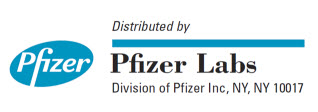
For more information, go to www.TALZENNA.com or call 1-800-438-1985.
LAB-1272-1.0This Patient Information has been approved by the U.S. Food and Drug Administration.
Issued 10/2018
PRINCIPAL DISPLAY PANEL - 0.25 mg Capsule Bottle Label
Pfizer
NDC 0069-0296-30
Talzenna™
(talazoparib) capsules0.25 mg
30 Capsules
Rx only
PRINCIPAL DISPLAY PANEL - 0.25 mg Capsule Bottle Carton
Pfizer
NDC 0069-0296-30
Talzenna™
(talazoparib)
capsules0.25 mg
30 Capsules
Rx only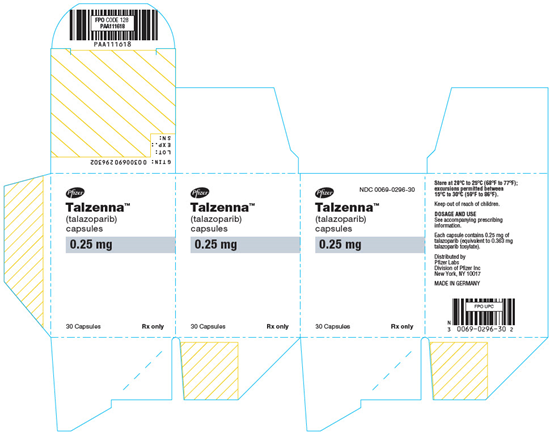
PRINCIPAL DISPLAY PANEL - 1 mg Capsule Bottle Label
Pfizer
NDC 0069-1195-30
Talzenna™
(talazoparib) capsules1 mg
30 Capsules
Rx only
PRINCIPAL DISPLAY PANEL - 1 mg Capsule Bottle Carton
Pfizer
NDC 0069-1195-30
Talzenna™
(talazoparib)
capsules1 mg
30 Capsules
Rx only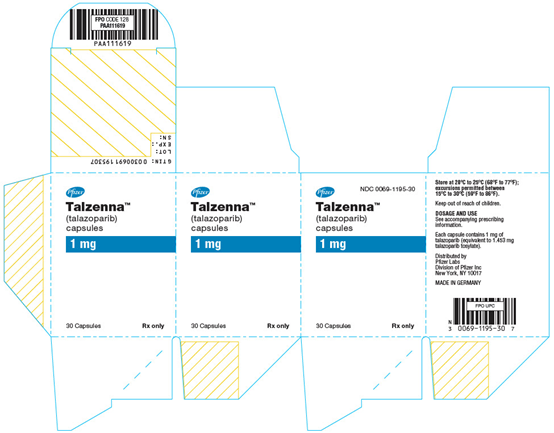
【备注】以上内容仅供参考,不作为用药依据,详情请参照药品附带说明书。
-
-
搜索更多相关资讯,请进入资讯页面








